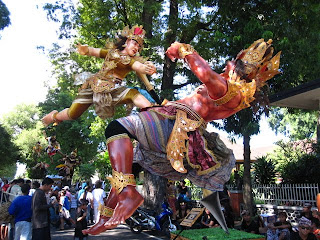The next morning we got a ride to Pak Nikanaya’s house, which is a beautiful traditional house in Denpasar. It was great to catch up with him again and revisit his wife. She made us local dishes, such as ayam batutu (spicy chicken with spinach like vegetable). Hopefully we will be able to spend more time with him while we’re in

* * * * * *
On the plane ride from
--The banjar is a grouping of anything between fifty and two hundred individual compounds. The word banjar originally referred to a row of houses, thus to the physical clustering of compounds into a neighborhood, with a temple and a community. Nowadays, most of these banjars have split, and the banjar community is no more strictly territorial. Two banjars can occupy the same territory, and banjar members sometimes live kilometres away from the core of community.
The banjar makes up an association called the "banjar suka duka" or "the association for the sharing of joy and pain" This refers to the function played by the group in the performing of specific social services or work the ayahan within the larger structure of the village (desa). These bonds are arguably the most important of all found in the network of village associations.
The basic social unit of the banjar is the couple (pekurenan). Only married couples are full banjar members and subjected to the banjar rights and obligations. The decisions are taken by the assembly (sangkep) of the banjar's male members, the krama banjar, which usually takes place every 35 days. The decisions are taken on the basis of unanimity, The banjar is now, since 1979, the lowest administrative structure of the national administration, directly under the authority of the perbekel / lurah (supra - village head) and beyond the traditional village headman (bendesa adat). There are also two types of kelian banjar, the kelian dinas, who is in charge of the administrative aspects of the banjar life, and the kelian adat, who looks after the customary aspects in collaboration with the bendesa adat. They usually work hand in hand, unless the two roles are assumed by the same person.--
Rudy lives in central Denpasar and he told us to go check out the festival statues (ogoh-ogoh) before the parade. I have to say right away, I have never met people in my life as magnanimous, kind, open, friendly, and charismatic a family as Rudy’s. He opened his doors to us even though we were complete strangers.
Rudy took us on a tour of his father’s home, where we stayed for Nyepi, which is over 100 years old. He explained how everything in the compound has a purpose and even the positioning of rooms has a specific function in their belief system. For example, the kitchen is the first house you pass when entering because it is central to life and important for the good spirits. The front door to his house is never opened except for ceremonies in order to keep out the bad spirits. The center of the Balinese home is specially reserved for ceremonies such as wedding and cremation. Surrounding these central features are the living quarters.
After getting to know his family a bit more, we went to look at the Nyepi festival statues. Nyepi is the Balinese new year, which takes places each year on the new moon in March. It is preceded by Melasti and a parade the night before. The first day of the new year is considered a Quiet Day where nobody works, uses electricity, drives or really does anything (the airport is closed, TV stations stop broadcasting, and every aspect of life comes to a standstill). The statues, or ogoh-ogoh, are some kind of paper mache project that each Banjar makes for the Nyepi parade. Their purpose is to scare away evil spirits before the new year as well as display the fight between good and evil. Some statues are very traditional while others show more modern day vices, and most just combine both themes. The best statues were lined up along the main square, only a block away from his house, so Pete and I took a walk around to take pictures and join the festivities. There were thousands of people taking photos, comparing the statues, eating, drinking and celebrating before The Quiet Day. Back at Rudy’s we were told to take a rest because the actual parade would take a very long time. At 6pm (a special time for Balinese because they believe it is a time for the evil spirits to come) we took part in a ritual where members of the house make offerings, bless the house with holy water, and scare away evil spirits. We all followed Rudy around the house as he waved burning palm leaves, another relative anointed each place with holy water, and we banged pots and cans with sticks to ensure all bad spirits were out of the home. Then we all gathered at Rudy’s banjar, Belaluan, and prepared for the parade. This included wearing traditional Balinese clothes, such as a sarong.












No comments:
Post a Comment